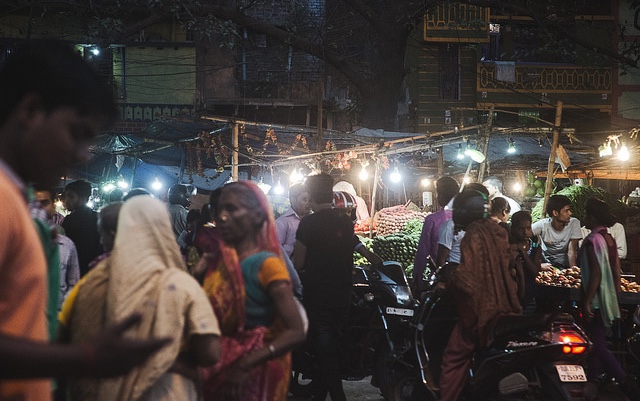Rapid urbanization is one of the most transformative phenomena of our world. Today, more than half of the world’s population lives in cities, and by 2050 projections estimate that two-thirds of the world’s population will be urbanized, adding some 2.5 billion people to cities. While rapid urbanization may be read as a feature of economic growth, especially in the context of low and middle income countries, it is not without challenges. The burgeoning size of cities obscures their inadequacies in providing decent living, health, and sanitary conditions to their most vulnerable populations. To mark World Cities Day (Oct. 31), here is a look at some of these problems—and the current limits of our knowledge of them.
Cities are increasingly home to persistent child undernutrition and stubborn micronutrient deficiencies, and are experiencing an alarming rise in overweight and obesity, shifting the burden of malnutrition from the rural areas where they have traditionally been most prevalent to urban ones. Nearly one in three children who are stunted–or short for their age–now live in urban areas, a proportion that has steadily risen since the mid-1980s. At the same time, between 1993 and 2002 poverty rates in urban areas of developing countries remained unchanged even as rural poverty rates declined (more recent data on comparing changes in urban and rural poverty rates is not available).
This transfer of poverty, food insecurity, and malnutrition from rural to urban areas demands a new understanding of the drivers of these problems and of the policies, programs, and interventions needed to tackle them. But most of the evidence and data on urban poverty and malnutrition that can help in designing effective interventions are either outdated or incomplete. Comprehensive, high quality research backed by adequate funding is urgently needed to address the challenges that rapidly growing cities present for urban poor.
The prospect of a better life drives most migration from villages to cities. But while cities generally provide better access to healthcare, clean water, secure food, and proper sanitation services, many of these perks are not accessible to the poorest and most vulnerable urban residents.
Nowhere are the challenges of urban poverty more visible than in slums, which are characterized by overcrowding, and inadequate access to safe water, sanitation, and infrastructure. These constrained living conditions expose slum residents, even more so vulnerable children, to multiple health risks emanating from poor hygiene and water and food contamination. Studies have found a much greater incidence of diarrheal illnesses, cholera, pneumonia, asthma and childhood undernutrition in slums than on average in the urban areas. By 2030, projections tell us that nearly 2 billion will be residing in slums in low- and middle-income countries.
The urban poor face specific challenges that demand tailored solutions based on evidence and research. While it is commonly known that the poor in cities typically have less access than their rural counterparts to traditional informal safety nets in the form of relatives and friends, research has recently found they also lag in coverage under formal safety nets. A 2014 survey found that, on average, only 21 percent of urban dwellers are covered by social safety nets, compared to 28 percent of their rural counterparts.
The rural poor still comprise a majority of the poor worldwide, so this discrepancy is partly due to the overall targeting of programs to poor populations. But it also highlights a general neglect of the urban poor, who face unique constraints and often live transient lives, which makes them difficult to reach through traditional safety net programs.
This puzzle is missing many pieces, and a key piece is research and evidence. Research can help us understand the extent and key drivers of poverty, food insecurity, poor health, and malnutrition in cities, and this information is necessary to design appropriate program and policy responses. There simply isn’t enough research to provide an evidence base on the constraints urban dwellers face to meet all their basic needs—including what drives their decisions about the foods they buy, where they shop, and how they respond to pressure to move away from traditional diets to consuming ultra-processed food and unhealthy diets. Many unanswered questions remain on the effects of the global and national food systems and how the urban food environment affects food access and food choices among the urban poor.
High quality research can help to provide answers to the many questions that need to be answered in order to protect the lives, health, and nutrition of the urban poor in growing cities around the world. Funding for such research has been utterly absent, despite widespread recognition that the nutrition transition to unhealthy diets high in saturated fat, added sugar, and salt, and in over-consumption of highly processed foods is spreading much more rapidly in urban than in rural areas and is driving the global epidemic of overweight, obesity and related non-communicable diseases.
For a very long time, developmental efforts have focused on addressing poverty, food insecurity and undernutrition problems in rural areas, but we are now seeing both similar and new challenges shift rapidly to cities in many regions. There is an urgent need to understand these shifting patterns and what poverty looks and feels like in cities. High-quality and well- targeted programs, and policy relevant research on life in cities could ultimately help to ensure that benefits of a city life are equally distributed, including among the most vulnerable. For this to happen, donors have to be part of the effort.
Marie Ruel is Director of IFPRI’s Poverty, Health, and Nutrition Division.







